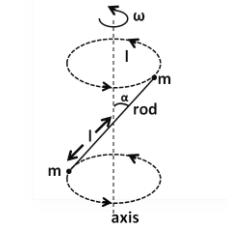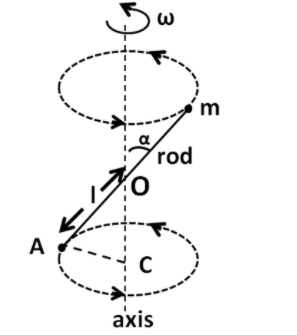Question
Question: A massless rod having length \(2l\) has equal point masses attached to its two ends shown in figure....
A massless rod having length 2l has equal point masses attached to its two ends shown in figure. The rod is rotating about its axis passing through its centre and making angle α with the axis. The magnitude change of momentum of rod, i.e., (dtdL) equals?

(A) 2m3ω3sinθcosθ
(B) ml2ω2sin2θ
(C) mv2sin2θ
(D) m1/2l1/2ωsinθcosθ
Solution
To solve this question, we need to find out the expression of the torque exerted on both the point masses, due to which they are rotating. The net torque on the system will be equal to the sum of the two torques on the two particles.
Formula used: The formula used to solve this question is given by
τ=rPF, here τ is the torque exerted on a particle due to a force of F, which is applied at a perpendicular distance of rp from the particle.
Complete step-by-step solution:
We know that the rate of change of momentum of a system is equal to the net external torque acting on the system.
So for finding out the rate of change of momentum of the rod, we have to find out the net external torque on the rod.
As can be seen on the figure, the torque on the given rod is due to the rotation of the two point masses which are attached to it.
We label the points on the given figure as shown in the figure below.

Here C is the centre of the lower circle. Now, we have
∠AOC=α (Vertically opposite angles)
In the triangle OAC we have
sinα=OAAC
⇒AC=OAsinα
From the figure, OA=l. Therefore we have
AC=lsinα
So the radius of the lower circle is equal to lsinα.
As the point mass m is rotating in the lower circle, so the centripetal force towards the centre can be given by
F=mω2lsinα ………...(1)
Now, for finding the torque exerted by this mass on the rod, we have to consider the torque about the centre of the rod, O. We know that the magnitude of the torque is given by
τ1=rPF...........(2)
From the above figure, we have
rp=OC
⇒rp=lcosα..................(3)
Putting (1) and (3) in (2) we get
τ1=mω2lsinα×lcosα
⇒τ1=mω2l2sinαcosα................(4)
Similarly the torque exerted by the other point mass on the rod is
τ2=mω2l2sinαcosα ………...(5)
As these torques are in the same direction, so the net torque on the rod is given by
τ=τ1+τ2
Putting (4) and (5) in the above equation, we finally get
τ=mω2l2sinαcosα+mω2l2sinαcosα
⇒τ=2mω2l2sinαcosα
We know that sin2θ=2sinθcosθ. Therefore we have
τ=mω2l2sin2α
Thus, the magnitude of the rate of change of momentum of the rod is equal to mω2l2sin2α.
Hence, the correct answer is option B.
Note: There also exists another formula for the torque, which is equal to the moment of inertia and the angular acceleration. But that formula is not applicable here because the rod is massless, which means that its moment of inertia will be zero.
